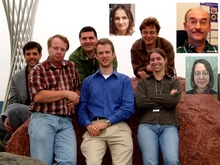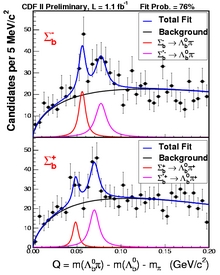 | Monday, October 23, 2006 |
|
Monday, October 23
Tuesday, October 24
Click here for a full calendar with links to additional information.
|
|
|
Secon Level 3 |
|
Monday, October 23 -Wisconsin Cheese -Corned Beef Reuben -Stuffed Chicken Breast -Mostaccioli Al Forno -Chicken Oriental Wrap Pineapple -Assorted Slice Pizza -Pacific Rim Rice Bowl The Wilson Hall Cafe accepts Visa, Master Card, Discover and American Express. |
|
Wednesday, October 25
Chez Leon Menu |
| Fermilab Today is online at: http://www.fnal.gov/today/ Send comments and suggestions to today@fnal.gov Fermilab Today archive Hurricane Relief Page Fermilab Today PDF Version Fermilab Result of the Week archive Fermilab Safety Tip of the Week archive Linear Collider News archive Fermilab Today classifieds Subscribe/Unsubscribe to |
| CDF finds exotic relatives of protons and neutrons |
|||
| |||
|
CDF scientists announced today (October 23, 2006) the discovery of two rare types of particles, exotic relatives of the much more common proton and neutron.
"These particles, named Sigma-sub-b [Σb], are like rare jewels that we mined out of our data," said Jacobo Konigsberg, University of Florida, a spokesperson for the CDF collaboration. "Piece by piece, we are developing a better picture of how matter is built out of quarks. We learn more about the subatomic forces that hold quarks together and tear them apart. Our discovery helps complete the 'periodic table of baryons.'"
| |||
 |
|||
| Baryons are particles made of three quarks. The particles can exist in a ground state (J=1/2) and an excited state (J=3/2). The CDF experiment discovered the positively charged Sigma-sub-b and the negatively charged Sigma-sub-b in both spin configurations. (Click on graphic to see related images, including a larger version of this graphic with a detailed description.) |
| Discover one, get three free | ||
| ||
|
The b quark is the heaviest quark to form "hadrons," which are composite
particles that come in groups of two or three bound quarks. The most
famous hadron is the proton, composed of two up quarks and a down
quark, and the basis for all material in the universe. Notice the proton does not contain a b quark. In fact, b quarks are rarely found in hadrons. That's why a high rate
of b-quark production makes the Tevatron a unique hadron factory, and
CDF physicists have recently capitalized on this by discovering four
new b-hadrons. Since the Λb (composed of u, d, and b quarks) was discovered a decade ago at LEP and the Tevatron, there has been only one known "b-baryon," or three-quark particle containing a b-quark. Past searches for other b-baryons, including the Σb (composed of either u,u,b or d,d,b quarks), have yielded nothing. That is, until now. A combination of high Tevatron production rate and clever real-time data selection give CDF about 3000 Λb's -- the world's largest sample of Λb's! After combining Λb candidates with additional particles called pions (see Figure), CDF physicists observe a very strong signal of about 240 events. Due to large backgrounds, physicists needed to use all the Tevatron data collected until 2006 to make an unambiguous discovery. The events are divided into four peaks: two for Σb(*)+ (composed of u,u,b) and two for Σb(*)- (composed of d,d,b). Since Σb+ is not an antiparticle of Σb-, they even have different masses! The discovery of Σb(*) particles and the measurement of their properties will provide important input to theorists studying how matter forms into hadrons. Welcome to four new particles! Click here for further reading | ||
 |
||
| From left: Michael Schmidt, (U. Chicago, previously JHU), Richard Tesarek (FNAL), Petar Maksimovic (JHU), Matthew Martin (JHU), Dmitry Litvintsev (FNAL) and Jennifer Pursley (JHU). Insets, from left: Elena Vataga (UNM), Igor Gorelov (UNM) and Sally Seidel (UNM). | ||
| Result of the Week Archive
|
| Hand injuries | ||
Not surprisingly, knife slips figured prominently in such injuries. In most cases purpose-built tools such as strippers would have been a better choice. Gravity has been another key factor. People got hurt when objects fell onto their hands or when they tried to catch a falling object. In addition, wrists got strained when people attempted to break a fall to the ground. Simply reaching out has resulted in lacerations when sharp edges were unexpectedly encountered. Besides letting things fall, you should also watch for edges on newly-worked metals and inner edges of metal cabinets to avoid cuts. And consider your hands' position when doing repetitive tasks. Repeated forceful wrist flexing aggravated carpal tunnel syndrome in a number of cases. To avoid hand injuries you should review the work process before you begin. How could my hands get hurt? Are there gloves that I should wear for safety? Am I using the best tool for the job? What happens if something falls? Are there sharp edges to watch for? Is repetitive motion causing wrist discomfort? Please check with the Medical Department. When caught early, such symptoms can often be resolved with a few workplace adjustments. |
|
October 18 - 20 - TeV and Pbar magnet replacement continues - Pbar verified stacking - TeV sector B3 cold compressor tripped off - Pbar magnet might have ground fault - TeV cooldown begins on the evening of 10/21/06
Read the Current Accelerator Update |
|
The New York Times, Opinion, October 20, 2006: The Universe on a String SEVENTY-FIVE years ago this month, The New York Times reported that Albert Einstein had completed his unified field theory - a theory that promised to stitch all of nature's forces into a single, tightly woven mathematical tapestry. But as had happened before and would happen again, closer scrutiny revealed flaws that sent Einstein back to the drawing board. Nevertheless, Einstein's belief that he'd one day complete the unified theory rarely faltered. Even on his deathbed he scribbled equations in the desperate but fading hope that the theory would finally materialize. It didn't.
In the decades since, the urgency of finding a unified theory has only increased. Scientists have realized that without such a theory, critical questions can't be addressed, such as how the universe began or what lies at the heart of a black hole. These unresolved issues have inspired much progress, with the most recent advances coming from an approach called string theory. Lately, however, string theory has come in for considerable criticism. And so, this is an auspicious moment to reflect on the state of the art.
|
|
Give an old coat to
A Taste of Taiwan
GSA Halloween Party
Professional Development
|


